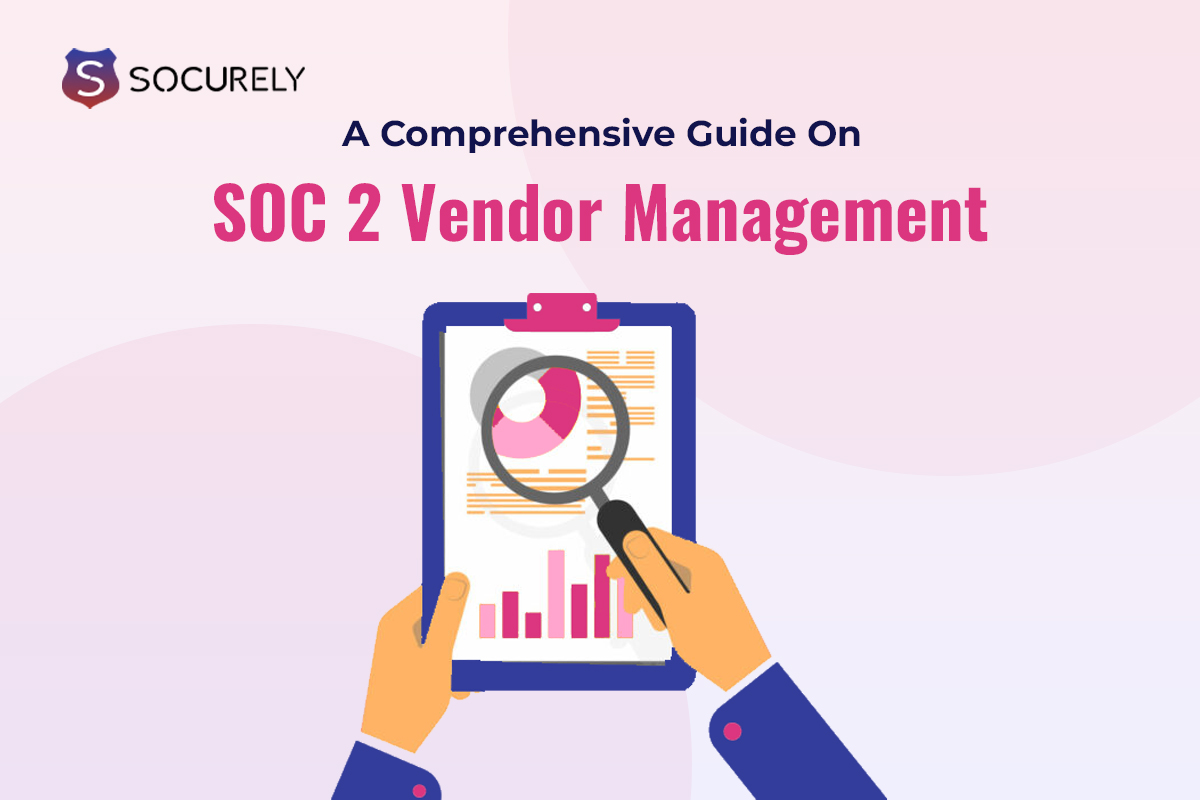In today’s interconnected digital landscape, businesses often rely on third-party vendors to range from cloud storage to payment processing. At this point, exploiters can gain access to sensitive information from the vulnerabilities of third-party vendors.
According to a survey by the Ponemon Institute,60% of data breaches involve a third party, underscoring the critical need for robust vendor management.
Businesses both small and large often overlook the importance of vendor management, which can cause such threats.
SOC 2 Framework is one effective compliance framework that gives importance to Vendor management and helps mitigate third-party-related risks.
As organizations strive to maintain high standards of data security, SOC 2 vendor management emerges as a pivotal component in ensuring compliance and safeguarding sensitive information. This comprehensive guide explores the essentials of SOC 2 vendor management, its benefits, challenges, and best practices to streamline the process.
What Is SOC 2 Compliance?
SOC 2, developed by the American Institute of CPAs (AICPA), focuses on five trust service principles: security, availability, processing integrity, confidentiality, and privacy. By adhering to these principles, organizations can demonstrate their commitment to safeguarding data and maintaining robust information security practices.
What Is SOC 2 Vendor Management?
SOC 2 vendor management is a robust process that assesses and monitors third-party vendors. This security process is used to ensure businesses meet the stringent criteria set forth by the SOC 2 framework.
SOC 2 Vendor management encompasses a few key activities like due diligence, risk assessment, contract management, and continuous monitoring. These practices help organizations identify potential risks associated with third-party vendors and implement measures to mitigate them, thereby protecting business data and reputation.
As part of the vendor management process, evaluation is placed on the vendor’s control environments, policies, and procedures. It identifies how the SOC 2 Framework protects sensitive data and adheres to compliance standard criteria. Not only that, organizations may reduce the cyber security risk connected to vendor relationships, safeguard data, and ensure that suppliers uphold security requirements by using SOC 2 vendor management.
What Are The Responsibilities Of SOC 2 Vendor Management?
At a glance, SOC 2 Vendor Management individual or team is responsible for:
- Conducting Due Diligence: Evaluating vendors’ security practices and compliance with SOC 2 requirements before entering into a partnership.
- Risk Assessment: Identifying and assessing risks associated with each vendor, considering factors such as data sensitivity and the vendor’s security posture.
- Contract Management: Ensuring that contracts with vendors include specific clauses related to SOC 2 compliance, data protection, and breach notification.
- Continuous Monitoring: Regularly reviewing vendors’ compliance status, conducting audits, and ensuring that vendors adhere to agreed-upon security practices.
- Incident Management: Coordinating with vendors to address any security incidents or breaches and implementing corrective actions.
Who Is A Vendor Manager In SOC 2 Compliance?
Parties other than the reporting organization being audited for SOC 2 compliance are referred to as SOC 2 vendors.
The organizations and companies listed below fit into the SOC 2 vendor categories.
Cloud service providers: Organizations that offer computer resources to businesses, such as Software as a Service (SaaS), Platform as a Service (PaaS), and Infrastructure as a Service (IaaS).
Data centers: Organizations that manage servers, store networking equipment, and store and retrieve data in a safe and secure environment.
IT Service Provider: Service providers that oversee and maintain an organization’s IT infrastructure are known as managed IT service providers.
Payment processors: Organizations that handle payments and keep track of financial information.
Vendors of human resource outsourcing: Businesses that oversee payroll, benefits, administration, and personnel records.
Accounting and audit firms: Organizations that carry out compliance assessments, financial audits, and other financial services.
Consulting firms: Organizations that offer guidance to companies on strategy, IT security, and business procedures.
Third-Part Service Provider- Any external party that offers any other type of service that affects the organization’s data security or systems is considered a third-party service provider.
How To Deal With The Third-Party Vendors?
Managing third-party vendors under SOC 2 compliance can be a complex and resource-intensive process. However, with the right approach and tools, you can ensure that you are following the SOC2 Vendor Management Plan-
1. Initial Assessment
Evaluate SOC 2 Report:
- Request and Review SOC 2 Reports: Obtain and carefully examine the vendor’s SOC 2 report to understand their compliance status and any areas of concern.
- Verify Coverage: Ensure the SOC 2 Reports address the relevant trust service principles critical to your organization’s operations.
Assess Security Policies and Practices:
- Examine Policies: Evaluate the vendor’s security policies, procedures, and controls against SOC 2 requirements.
- Alignment with Standards: Confirm that their security practices are consistent with SOC 2 standards and your organization’s security requirements.
Automation Tools:
- Streamline Evaluation: Use automated SOC 2 Vendor management tools to facilitate the assessment process, reducing manual effort and improving accuracy.
2. Risk-Based Approach
Prioritize Vendors by Risk Level:
- Categories Vendors: Sort vendors based on the sensitivity of the data they handle and the potential impact on your organization.
- Focus on High-Risk Vendors: Allocate more resources to monitor and manage high-risk vendors closely.
Automated Risk Assessment:
- Continuous Evaluation: Implement automated risk assessment tools to continuously evaluate each vendor’s risk level.
- Proactive Risk Management: Use these tools to identify potential risks early and take appropriate measures.
3. Contractual Agreements
Include SOC 2 Compliance Clauses:
- Compliance Requirements: Ensure all vendor contracts include specific clauses mandating SOC 2 compliance.
- Data Protection and Security: Specify SOC 2 requirements for data protection, security practices, and breach notification protocols.
Contract Management Software:
- Track Agreements: Use contract management software to monitor and manage compliance clauses across all vendor contracts.
- Consistency in Compliance: Ensure all contracts consistently reflect your organization’s compliance requirements.
4. Regular Audits
Schedule Regular SOC 2 Audits:
- Plan Audits: Conduct regular audits to review the vendor’s compliance status and security practices.
- Identify Gaps: Use audit findings to identify compliance gaps and areas needing improvement.
Automated Audit Scheduling and Reporting:
- Streamline Audits: Utilise automated tools to schedule SOC 2 audits and generate compliance reports efficiently.
- Maintain Consistency: Ensure a consistent SOC 2 Vendor audit schedule and accurate tracking of compliance over time.
5. Continuous Monitoring
Real-Time Monitoring:
- Monitor Compliance: Perform continuous SOC 2 Vendor management monitoring to check real-time compliance status using real-time monitoring tools.
- Identify Changes: Quickly detect and address any changes in the vendor’s security posture.
Automated Alerts and Notifications:
- Proactive Alerts: Set up automated alerts for any deviations from SOC 2 compliance.
- Immediate Action: Use these alerts to take immediate corrective action and mitigate risks.
6. SOC 2 Vendor Management Plan
Develop a Comprehensive Plan:
- Define Roles and Responsibilities: Clearly outline the roles and responsibilities of all parties involved in vendor management.
- Communication Protocols: Establish communication protocols for regular updates and incident reporting.
Automated Management Tools:
- Streamline Processes: Use automated management tools to track, manage, and report on vendor compliance activities.
- Enhance Efficiency: Ensure that all compliance activities are streamlined and efficiently managed.
7. Incident Response Plan
Develop a Joint Incident Response Plan:
- Collaborate with Vendors: Work with vendors to create a comprehensive incident response plan.
- Define Procedures: Outline procedures for identifying, reporting, and addressing security incidents.
Automated Incident Response:
- Speed Up Response: Implement automated tools to quickly identify and respond to security incidents.
- Minimise Impact: Ensure prompt action to mitigate potential damage.
8. Documentation and Reporting
Maintain Detailed Documentation:
- Keep Records: Document all vendor assessments, audits, and compliance activities comprehensively.
- Ensure Accessibility: Make sure documentation is easily accessible for internal review and external audits.
Automated Documentation and Reporting:
- Accuracy and Efficiency: Utilise automated tools to streamline record-keeping and ensure accurate reporting.
- Generate Reports: Produce detailed compliance reports to demonstrate adherence to SOC 2 standards.
What Are The Benefits Of SOC 2 Vendor Management?
Implementing robust SOC 2 vendor management practices offers numerous benefits, like-
- Enhanced Security: Ensures that third-party vendors adhere to stringent security practices, reducing the risk of data breaches.
- Regulatory Compliance: Helps organizations meet regulatory requirements related to data protection and security, avoiding legal penalties.
- Improved Trust: Builds trust with clients and stakeholders by demonstrating a commitment to high standards of data security and vendor management.
- Risk Mitigation: Identifies and mitigates risks associated with third-party vendors, protecting the organization’s data and reputation.
- Streamlined Operations: Establishes clear processes for managing vendors, making it easier to monitor compliance and address security issues.
- Competitive Advantage: Differentiates your organization in the market by showcasing robust vendor management and compliance practices.
**Also read the myths about SOC 2 Compliance with us!
Steps To Make SOC 2 Vendor Management Smooth
Although navigating SOC 2 vendor management might be difficult, it is essential to protect your company from threats posed by third parties that could damage your brand. What then is the remedy?
Socurely suggests the automation of compliance.
You may efficiently manage the possible risks connected with suppliers by using a complete compliance management and automation system like Socurely SOC 2 Compliance framework, which puts vendor management on autopilot and eliminates the need for a vendor management staff.
Socurely also suggests a few measures that you can apply for a smooth SOC 2 Vendor Management-
- Define Requirements: Clearly define your organization’s security and compliance requirements for vendors, based on SOC 2 principles.
- Vendor Selection: Choose vendors with a proven track record of SOC 2 compliance and strong security practices.
- Documentation: Maintain detailed documentation of all vendor assessments, audits, and compliance activities.
- Automation Tools: Utilise automation tools to streamline vendor management processes, such as risk assessment and continuous monitoring.
- Collaboration: Foster a collaborative relationship with vendors, encouraging them to actively participate in maintaining compliance.
- Continuous Improvement: Regularly review and update your vendor management practices to address evolving security threats and compliance requirements.
Conclusion
One very important procedure that needs a lot of attention is SOC 2 vendor management. This entails picking the best vendors, evaluating their level of compliance, and making sure they meet the most recent SOC 2 compliance standards.
This is the role that Socurely plays.
With the use of a compliance automation tool by Socurely, you can keep track of and oversee all vendor management-related activities as they are completed. In addition, the platform assists with automating vendor risk evaluations, creating efficient incident response plans, and configuring alerts for approaching control failures.







